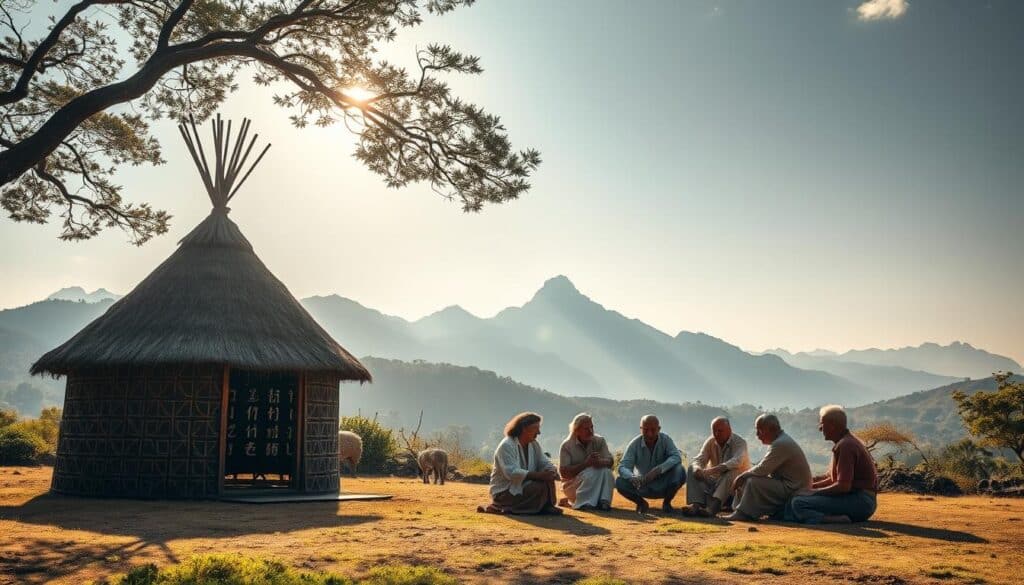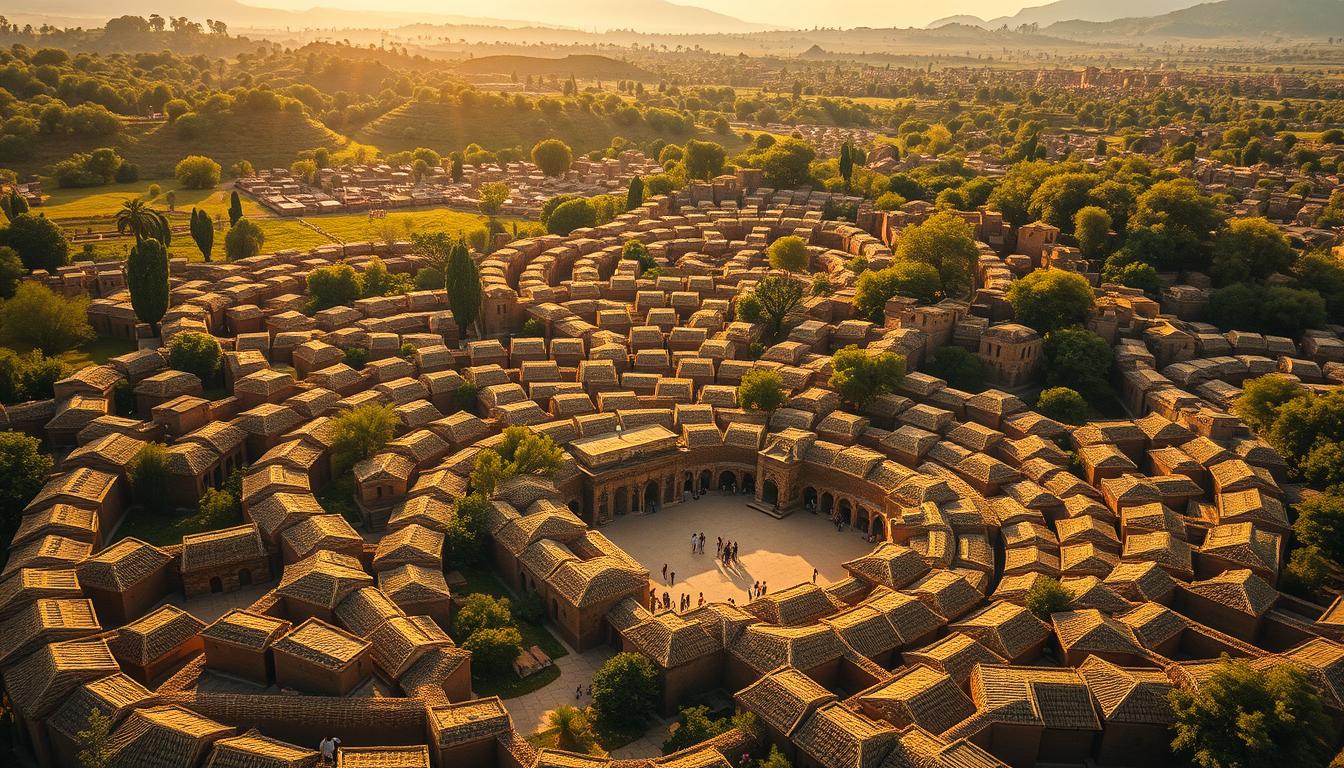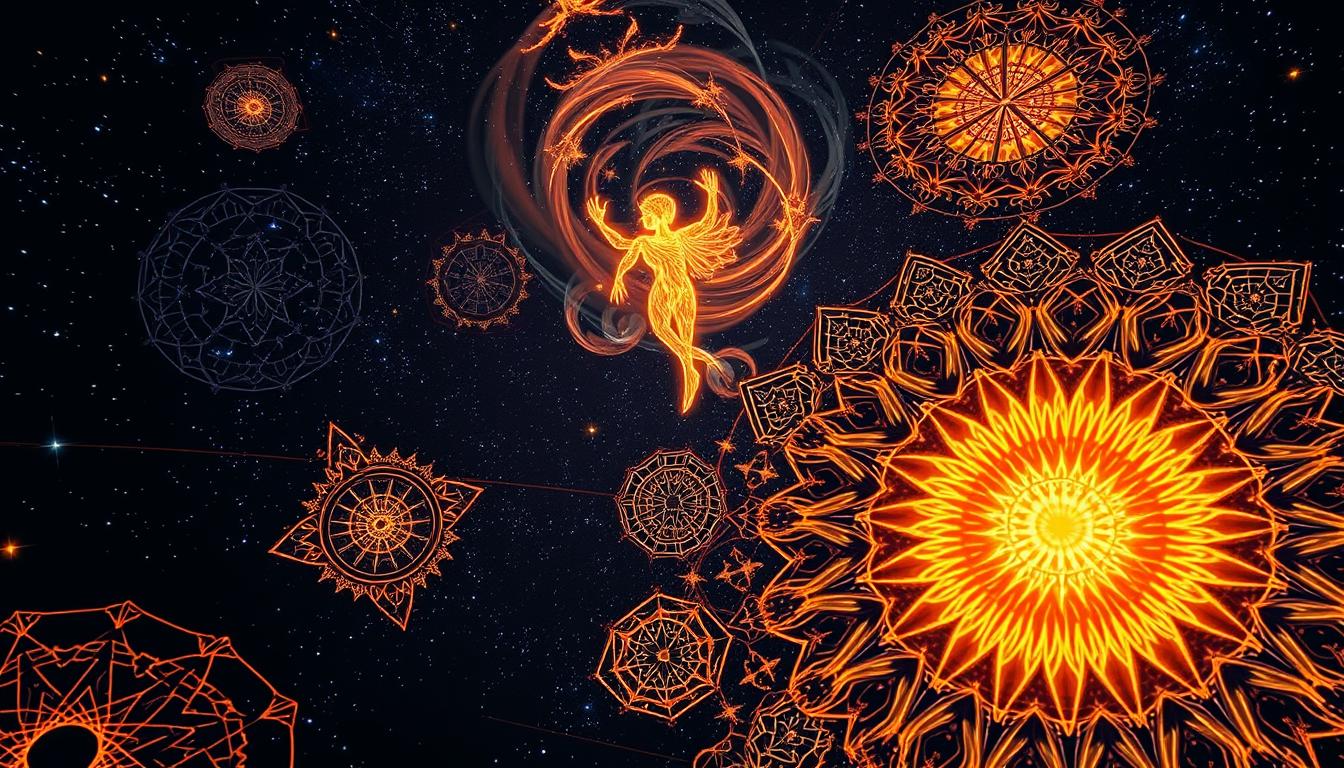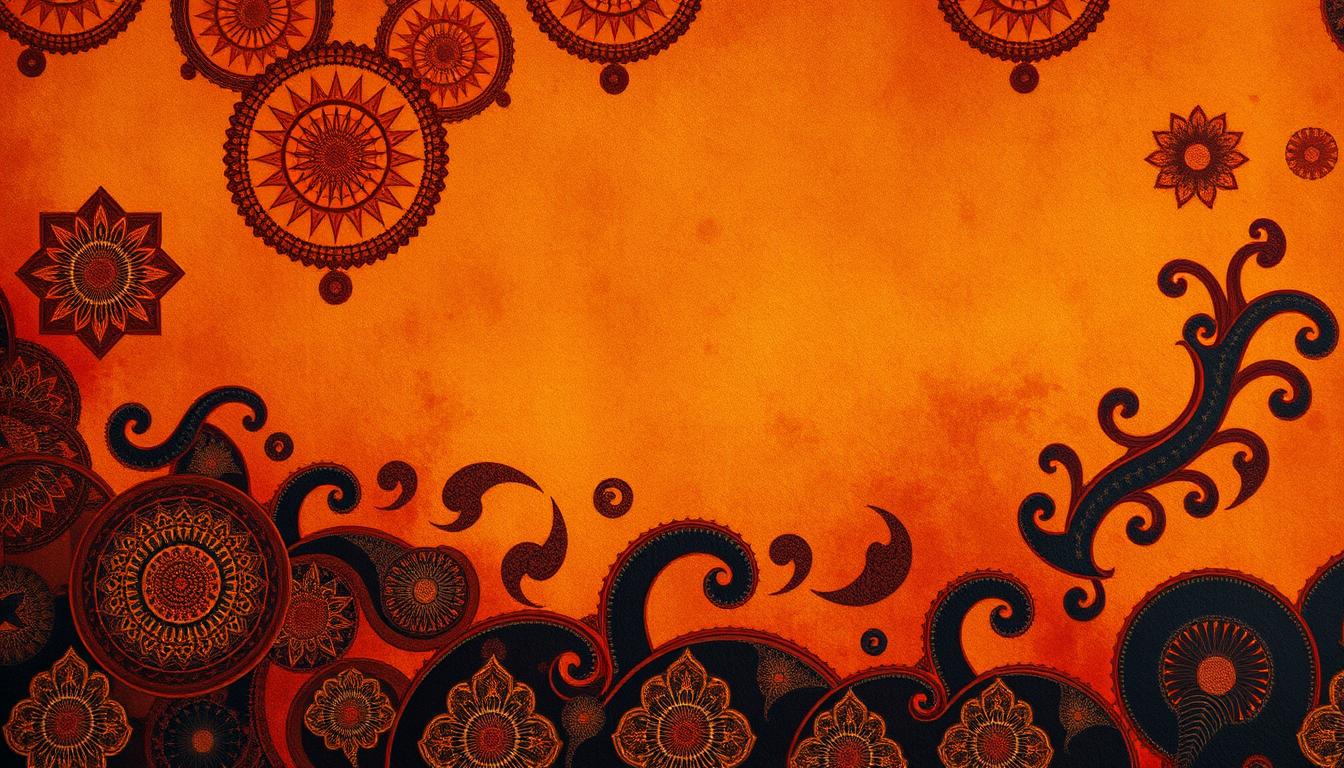Exploring Indigenous cosmologies unveils a deep respect for nature that goes back centuries. It ties closely to fractals and math. Indigenous groups, particularly in Africa, noticed nature’s complex patterns way before modern science did. This tradition shows how they saw fractal geometry, a concept later named in the West by Benoit Mandelbrot.
But these complex patterns are not new. They are part of Indigenous traditions and beliefs. They show us that calling such knowledge simple or basic is incorrect. This introduction helps us see how these societies understood their world through fractals. It shows the depth of Indigenous pre-science.
Introduction to Indigenous Cosmologies and Fractals
Indigenous knowledge holds deep insights into the universe. It’s shaped by thousands of years of watching and learning. These aren’t just stories. They show a fractal reality, where patterns in nature repeat on many levels. Many Indigenous people see fractals everywhere. They see how these patterns show life’s interconnections.
This knowledge is key to Indigenous identity. It teaches living in harmony with nature. For example, their stories often use fractal patterns. These stories tell about changing seasons, weather, and life cycles. They make people feel they belong and understand the world, which is like modern math concepts.
Looking at Indigenous knowledge and fractals shows how universal these patterns are. It shows how rich Indigenous stories are. And it tells us how they help us see science in new ways. This connection celebrates how culture and nature are deeply linked.

The Significance of Fractals in Nature
Fractals show us an exciting way to see nature’s complex structures and patterns. They use concepts like self-similarity and scaling to explain complexity in nature. The Mandelbrot fractals changed how we see these patterns, going beyond ordinary geometry.
Understanding Fractal Geometry
Fractal geometry lets us study repeating shapes and patterns at different sizes. This idea of self-similarity means small parts of a fractal look like the whole thing. This creates endless complexity. We see this in coastlines, snowflakes, and trees, showing a deep link between math and nature.
Benoit Mandelbrot’s Legacy
Benoit Mandelbrot greatly pushed forward fractal geometry, making it part of mainstream science. His work with Mandelbrot fractals helped us understand complex systems in economics, biology, and physics. He showed that fractals can explain nature’s irregular shapes, changing how we view the world.
How Indigenous Cosmologies Understood Fractals Long Before Modern Science
Indigenous cosmologies have a deep relationship with fractal patterns. These patterns are common in African beliefs and practices. For years, African cultures have used these repeating patterns in their art and architecture. They also see them in nature. This shows they knew about fractals, connecting them with spirituality and everyday life.
Fractal Patterns in African Ontology
In African beliefs, fractals show how everything is connected. Art often uses repeating shapes and designs. This means more than just art. It shows a belief that everything in the universe is related. Elements include:
- Patterns in textiles and beadwork, reflecting natural forms and cycles.
- Architectural layouts that embody fractal characteristics, mirroring organic structures.
- Symbols in rituals that resonate with the fractal nature of the universe.
This way of thinking connects the natural world with the spiritual one. Indigenous peoples saw fractals in their daily lives. They used them to understand their environment and their beliefs. This knowledge was not just useful. It also made their view of the world richer, showing the deep links between people, nature, and the whole universe.
The Intersection of Mathematics and Indigenous Knowledge
Mathematics and Indigenous knowledge intertwine, showing us different ways cultures view and use math. Figures like Claudia Zaslavsky and Ron Eglash prove math’s deep roots in African traditions. They show us that math goes beyond Western ideas, sharing a global cultural story.
Claudia Zaslavsky’s Contributions
Claudia Zaslavsky has explored how deep math is in Indigenous knowledge. Her book, “Africa Counts,” looks at math in African societies. She shows how math is used in daily life, from counting to shapes, challenging old views on who can be “mathematical.”
Ron Eglash’s Research on African Fractals
Ron Eglash shows us the connection between African fractals and math. His studies reveal fractals in African culture, not just in theory but in buildings and art. He finds math in traditions, linking Indigenous knowledge with math in a unique way.
Fractals and Indigenous Architecture
Fractal ideas are closely linked to Indigenous architecture, mirroring the natural world in their designs. Indigenous groups show a solid grasp of geometry, especially in how they arrange their villages. These arrangements often show patterns that repeat, showing a close bond between the people and their surroundings.
Self-Similarity in Village Layouts
Many Indigenous villages have a design that mimics fractal patterns. The way houses and community areas are set up reflects the shapes in nature. This setup helps connect the community, making it easier for people to interact and work together.
Circular Designs in Traditional Settlements
Circular layouts are common in the architecture of different Indigenous cultures. These round shapes mirror nature’s cycles and help bring the community together. Circular areas are often centers for events and rituals, highlighting the value of togetherness and shared moments.
The Role of Fractals in Indigenous Divination Practices
Fractals are very important in Indigenous divination. They’re used as tools for insight and making interpretations. Practices like geomancy and sand divination show off fractals, mirroring patterns in the universe. They symbolize how everything is connected, from people to the cosmos.
In geomancy, interpreting patterns from earth markings shows fractal geometry’s impact. The geometric shapes split in ways that reflect the world’s fractal nature. This reveals deeper meanings. Sand divination also uses complex sand designs. These mimic fractal motifs.
Using fractals in divination shows a deep understanding of how everything is connected. Practitioners tap into life’s deep story with the help of fractals. They see the complexity of life and use it to make choices and see future paths.
Fractal Geometry in Mesoamerican Cultures
Mesoamerican cultures offer a unique way to see how fractal geometry and culture connect. They show a deep cosmic understanding through fractal ideas in their traditions and symbols. Their art and buildings demonstrate how fractal geometry is more than math. It’s a key part of their view of the world.
Ritual Miniaturization and Symbolic Representation
Ritual miniaturization shows fractal geometry’s role in Mesoamerican traditions. Miniatures in rituals mimic the larger universe, linking the physical and spiritual. These artifacts, symbolizing celestial beings, connect with the divine and mirror complex beliefs. Through these miniatures, people blend the real with the spiritual while capturing their faith’s core.
The Cosmic Order in Mesoamerican Worldviews
The idea of cosmic order in Mesoamerican cultures comes from fractal geometry. Their calendars, buildings, and art use symbols to show time cycles and celestial patterns. These fractal symbols suggest everything is connected. They highlight the universe’s structure and show respect for life’s deep rhythms and the cosmos.
The Impact of Fractals on Technology and Science
Fractals have deeply changed how we see technology and science. They are key in digital design and studying complex systems. The more we learn about fractal geometry, the more we understand its effects.
Fractals in Digital Design and Technology
In digital design, fractals are very important. They are used in things like computer graphics and showing data clearly. Fractal compression makes pictures clearer without making them too big. This shows how useful fractals are in tech. Their use leads to amazing visuals and better experiences on digital platforms.
Revolutionizing Our Understanding of Complex Systems
Fractals also help us study complex systems. These can be things in nature, society, or technology. By using fractals to study data, scientists can find patterns they might miss otherwise. This new way of looking at things aids many fields. For example, ecology, physics, and finance, where understanding complex systems is crucial.
Challenges in Bridging Indigenous Knowledge and Western Science
Bridging Indigenous knowledge with Western science is tough due to historical biases. These have led to misunderstandings. The big gap in knowing nature and reality causes conflicts. A main issue is Western science values hard facts more, which can ignore Indigenous wisdom.
Educational systems often limit their view of science. They don’t fully see the worth of Indigenous knowledge. This makes real talks hard and reinforces wrong stereotypes about Indigenous views. To fix these problems, we need settings that value both Indigenous wisdom and science.
- Misunderstandings of Indigenous epistemology often lead to the devaluation of traditional practices.
- Institutional biases can hinder collaboration between Indigenous communities and scientific researchers.
- Lack of platforms for sharing Indigenous knowledge contributes to the continued gap between the two systems.
Good communication and respect are key to merging cultures. We might need joint research efforts that respect all knowledge. This could help us all understand the world better.
Conclusion
We’ve learned a lot about how Indigenous cosmologies and fractals connect. These ancient cultures saw the importance of fractals in nature. They wove this knowledge into their beliefs, daily lives, and understanding of the world. This shows us how valuable it is to mix different types of knowledge.
Talking with Indigenous people about their knowledge and today’s science is very exciting. It helps us see new ways to think about and explore the world. We should work together more, valuing Indigenous insights to push science and learning forward.
This combination shows us fractals are key in both old traditions and new science. It tells us we need to open up science to include more viewpoints. By doing this, we create room for new ideas and a greater respect for different cultures’ views of the world.



